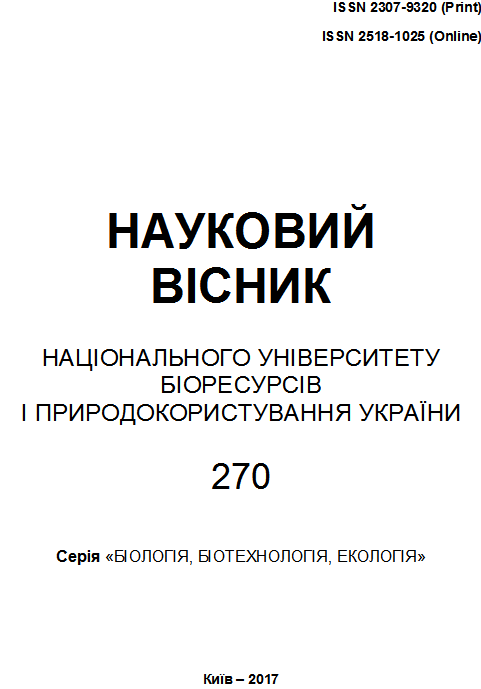DETERMINATION OF GENOTOXICITY OF NANOCOMPOSITES USING SOSTYPE BIOSENSOR
Abstract
In recent years in Ukraine and the world there has been a rapid development of a new branch of science – nanotechnology. Due to their size, shape and properties, nanoparticles have received a great demand in medicine, food industry, machine building, agriculture. But along with many positive aspects of nanomaterials, scientists also warn about their danger with respect to living organisms, so studying the biological effects of nanomaterials is a must before using them. Biosensor diagnostic methods have become very popular, since these devices can quickly and easily estimate the level of toxicity of foreign agents. The genotoxicity of nanocomposites based on saponite with the help of SOS-type biosensors based on fiber optics was investigated. SOS – the biosensor operates on the basis of recording the damage of bacterial DNA, restored by the reparation systems of bioluminescent bacteria. According to the results of the research it was shown that newly synthesized nanocomposites based on saponite do not possess genotoxicity in the concentration range of 300-600mg/l. Nano-sized SiO2, which is a composite nanocomposite, demonstrated genotoxicity relative to the reference culture in the concentration range of 300-600mg/l.
References
Chekman, I. S., Serdiuk, A. M., Kundiiev, Iu. I., Trakhtenberh, I. M., Kaplinskyi, S. P., & Babii, V. F. (2009). Nanotoksykolohiia: napriamky doslidzhen (ohliad) [Nanotoxicology: Research Areas (Review)]. Environment and Health, 48 (1), 3-7.
Borysevych, V. B., & Kaplunenko, V. H. (2012). Nanomateryalы y nanotekhnolohyy v veterynarnoi praktyke [Nanomaterials and nanotechnologies in veterinary practice]. K .: VD «Avicenna», P. 512.
Nel, A., Xia, T., Mädler, L., & Li, N. (2006). Toxic potential of materials at the nanolevel. science, 311(5761), 622-627.
Yah, C. S., Simate, G. S., & Iyuke, S. E. (2012). Nanoparticles toxicity and their routes of exposures. Pakistan journal of pharmaceutical sciences, 25(2).
Quilardet, P., & Hofnung, M. (1993). The SOS chromotest: a review. Mutat. Res, 297, 235-279.
Oda, Y., Nakamura, S. I., Oki, I., Kato, T., & Shinagawa, H. (1985). Evaluation of the new system (umu-test) for the detection of environmental mutagens and carcinogens. Mutation Research/Environmental Mutagenesis and Related Subjects, 147(5), 219-229.
Baumstark-Khan, C., Khan, R. A., Rettberg, P., & Horneck, G. (2003). Bacterial Lux-Fluoro test for biological assessment of pollutants in water samples from urban and rural origin. Analytica Chimica Acta, 487(1), 51-60.
Verschaeve, L., Van Gompel, J., Thilemans, L., Regniers, L., Vanparys, P., & Van der Lelie, D. (1999). VITOTOX® bacterial genotoxicity and toxicity test for the rapid screening of chemicals. Environmental and molecular mutagenesis, 33(3), 240-248.
Polyak, B., Bassis, E., Novodvorets, A., Belkin, S., & Marks, R. S. (2000). Optical fiber bioluminescent whole-cell microbial biosensors to genotoxicants. Water Science and Technology, 42(1-2), 305-311.
Savchuk M. V., Starodub M. F. (2017). Vplyv Nb-vmisnykh nanokompozytiv na osnovi saponitiv na posivni yakosti nasinnia kukurudzy [Effect of Nb-containing nano-compositions on the basis of saponite on the seed quality of corn seeds]. Quarantine and plant protection, 4 (6), 5-7.
Starodub N. F., Taran M. V., Shpirka N. F., Shavanova K. E. (2016). Fiber optic SOS-type biosensor for the control of the genotoxicity of some environmental objects. World journal of engineering research and technlogy,Vol. 2, 123-130.
Downloads
Published
Issue
Section
License
Relationship between right holders and users shall be governed by the terms of the license Creative Commons Attribution – non-commercial – Distribution On Same Conditions 4.0 international (CC BY-NC-SA 4.0):https://creativecommons.org/licenses/by-nc-sa/4.0/deed.uk
Authors who publish with this journal agree to the following terms:
- Authors retain copyright and grant the journal right of first publication with the work simultaneously licensed under a Creative Commons Attribution License that allows others to share the work with an acknowledgement of the work's authorship and initial publication in this journal.
- Authors are able to enter into separate, additional contractual arrangements for the non-exclusive distribution of the journal's published version of the work (e.g., post it to an institutional repository or publish it in a book), with an acknowledgement of its initial publication in this journal.
- Authors are permitted and encouraged to post their work online (e.g., in institutional repositories or on their website) prior to and during the submission process, as it can lead to productive exchanges, as well as earlier and greater citation of published work (See The Effect of Open Access).

